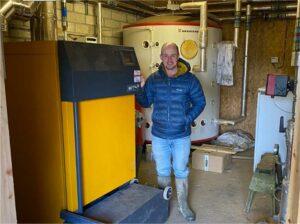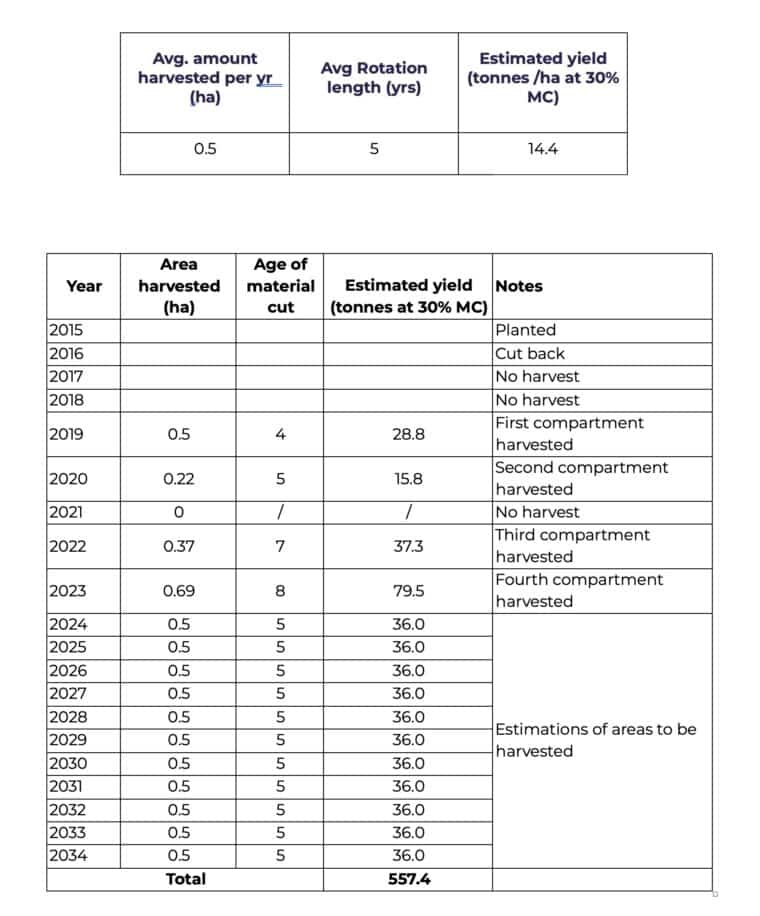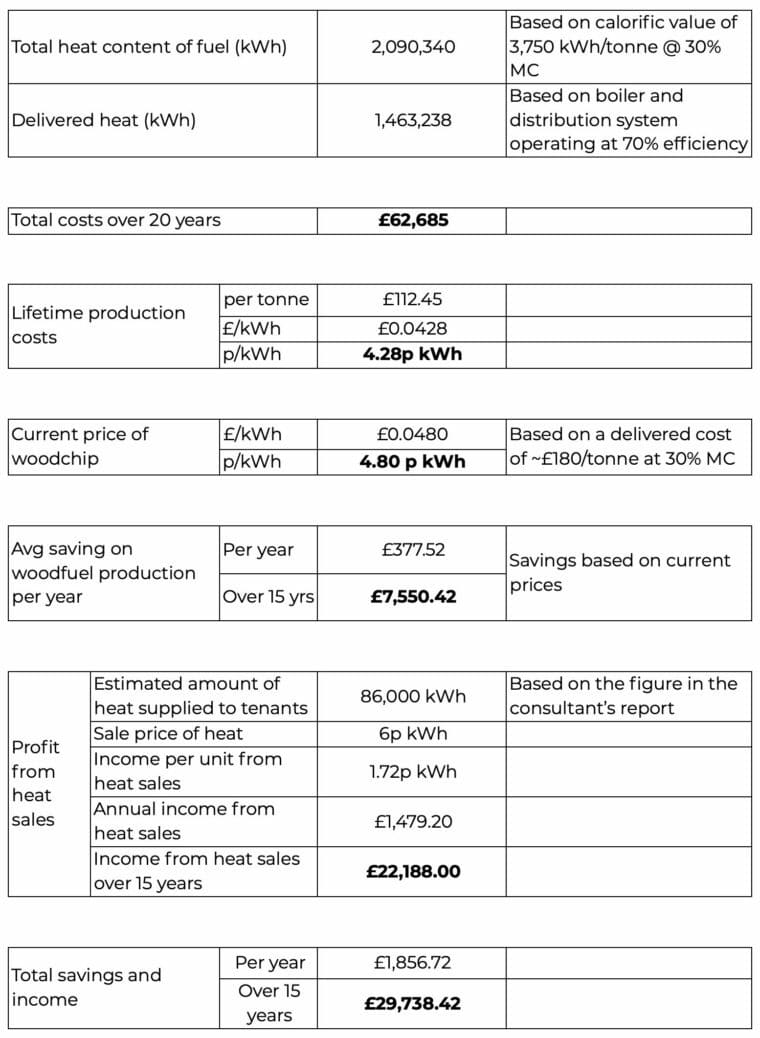Case Study: SRC Willow – self supply and use in a farm-scale community heating scheme
Abstract
This case study features a successful farm-scale community heating scheme using short rotation coppice (SRC) willow as a fuel source. The project has been cost-effective and provided a range of benefits, including energy self-sufficiency, reduced carbon emissions, and potential biodiversity enhancements1.
The study examines the challenges faced in establishing and managing the SRC willow plantation, including the need for hard standing space to store and dry rods prior to chipping, the capacity of the fuel store, and the access to wetter areas of the plantation.
Also explored is the harvesting and chipping process, and the issues that have arisen with the biomass heating system.
Overall, the case study demonstrates that SRC willow can be a viable and sustainable energy source for farms and rural communities.
SRC Willow – Self Supply and use in a farm-scale community heating scheme
Background
Umberleigh Barton Farm is a working mixed farm situated in North Devon, belonging to the Andrew family. The Andrew’s have installed a 130-kilowatt (kW) biomass boiler to supply space and water heating to their farm buildings and six residential properties on site, four of which are rented out to tenants.
The 130-kW biomass boiler requires around 60 tonnes of wood chips per year. This is sourced from local woodfuel providers and from 3.95 hectares of short rotation coppice (SRC) willow planted by Mr. Andrews in 2015. At full capacity the SRC willow plantation could supply 100 % of the wood chip needed to run the boiler.
Planting and Harvesting
The decision-making process involved in the selection of SRC as a crop and installation of the boiler is explained in the earlier case study. The most important elements were the desire to achieve self-sufficiency and “insulate” the Andrew family against potential future woodfuel price rises.
The SRC plantation was established 18 months after the boiler was installed. The intention was to hand plant the willow but ultimately Mr Andrew decided to pay to get a specialist contractor (Rickerby Estates based in Cumbria) to plant it using the Step Planter. The additional cost of planting (due to the distance that the contractor had to transport labour and machinery) was offset by the decision to not install rabbit fencing.
Specialised harvesting machinery is not available locally, so the decision was made to plan for manual harvesting with chainsaws and manual onsite processing into woodchips using a static chipper.
The aim was for one quarter of the crop (~1 ha) to be harvested every year to provide a supply of home-grown material to supplement purchased woodchip. Although this involves manual labour and additional handling, the cost of SRC woodfuel is significantly lower in price than purchased woodchip.
As the crop was to be harvested manually it was decided to use wider spacings between the willow rows (2m between rows rather than the normal 1.5m). This gave the plantation a stocking rate of 10,000 per hectare (compared to the commercial standard of ~15,000 per hectare). Mr Andrew followed best practice advice that was available at the time and cut back the establishment year growth in order to promote coppicing. More recent practice is to leave the crop intact and harvest the crop in its third year.
The first harvest was taken in Jan/Feb 2019 (three-year shoots on four-year root stocks = S3R4). The planned harvest regime was adjusted each year based on circumstances, and has resulted in a lower area being harvested than planned and longer rotation periods, with the area harvested each year as follows:
- Jan/Feb 2019: 0.50 hectares (S3R4)
- Jan/Feb 2020: 0.22 hectares (S4R5)
- Jan/Feb 2021: no harvest due to an issue with the chipper (see Challenges)
- Jan/Feb 2022: 0.37 hectares (S6R7)
- Jan/Feb 2023: 0.69 hectares (S7R8)
Successes
The project has been an out and out success. A delay in planting caused by a hold up in the award of the Energy Crops Scheme grant allowed Mr Andrew more time to get the land clear of weed competition. In addition, the machine planting was very successful with only a few misses. Both enabled the crop to get away quickly and achieve canopy closure. In addition, the strong establishment year growth and cut back enabled excellent coppicing, which further suppressed weed competition and provided the best foundations for a high yielding crop.
Mr Andrew was also one of the first people to commercially plant into his mix the variety ‘Endurance’ which was released onto the market in 20152. This variety has consistently been the highest performing variety in yield trials in the West of England, Wales and Northern Ireland. It is particularly suited to slightly wider spacings and longer rotations. Five varieties were planted (Endeavour, Endurance, Resolution, Terra Nova and Tordis).
Analysis has indicated that Endurance and Endeavour have superior woodfuel qualities to other varieties including: lower moisture content at harvest, higher lignin content and higher bulk density . During the visit a sample of the wood chip was taken, and the bulk density was found to be 242 kg/m3.
The aim is to harvest the crop in Jan/Feb each year. At this point the willow is dormant so there is no leaf contamination. Wood chips contaminated with leaves tends to be higher in chlorine which can cause corrosion of the boiler’s combustion unit and so this issue is avoided. The excellent yield and longer growing cycle (5 year as opposed to typical 3-year rotation) has meant that the woodchip produced has a much lower bark to wood ratio than typical SRC chip, and the woodfuel produces a lower ash content than would be expected (normally this is 2% but it is estimated that this is reduced by around 25%). Mr Andrew removes a three-quarter full wheelbarrow of ash every fortnight in winter.
So far, there have been no issues with the operation of the boiler. One batch of willow fuel was a little wetter than normal and this resulted in clinker (where ash fused into a hard crystalline deposit), but this was the only thing to report. Mr Andrew has the boiler serviced twice a year which keeps it in very good condition.
The low-cost nature of the venture (see Costs and Benefits section) has enabled Mr. Andrew to maintain the cost of heat supplied to his tenants at 6p/kWh. This is the same as was charged back in 2015.
By contrast at the time of writing (September 2023) the average price of natural gas in the UK is 8p/kWh (and during the Cost-of-Living Crisis from winter 2022 to spring 2023 it was much higher at over 14p/kWh).
Mr Andrew also feels there are additional biodiversity benefits. For instance, willow catkins provide pollinators with nectar and pollen in late winter and early spring; Mr Andrew has permitted a local beekeeper to place several hives around the willow plantation.
In addition, numerous bird species were seen in and around the crop during the case study visit. These included the amber listed Grey Wagtail and Wren, as well as green listed Pied Wagtail, Long Tailed Tit, Blue Tit, Chiff Chaff, Robin and Blackbird. A planned ornithologist’s visit later in the year will explore the role of the SRC in attracting these and other species.
Challenges
The biggest challenge has been the lack of hard standing space to store and dry rods prior to chipping. Mr Andrew created a hard-core pad (~350 square metres) before the SRC was planted but this is not sufficient space and has limited the amount that can be harvested in any one year.
In addition, the capacity of the fuel store means that the rods can only be chipped sequentially. The barn can only handle five trailer loads at a time. The farm uses a telehandler for both the chipping operation (a grab) and for pushing the tipped woodchip into the fuel hopper (a bucket). Replacing one attachment with the other adds time to the processing procedure.
Some parts of willow plantation are in wetter areas than others. These are not so easy to access and further away from the area used for rod storage. So far, this part of the plantation has not been harvested.
As the mature willow is over 8m tall it is important to harvest on a wind free day. This assists the chainsaw operative to orientate the willow to fall in a consistent direction which subsequently allows the telehandler to efficiently grab the willow. The harvesting job is done over a period of weeks to ensure that it doesn’t become boring or lead to repetitive back strain for the operative.
The estimated times required to harvest the SRC, remove the rods to the storage area and then do the chipping are all longer than was predicted (see Table 1). This is a result of the complexity of the harvesting and manoeuvrability of the willow, the space constraints and the need to change attachments to the telehandler.
The chipping process is carried out in September. As willow rods dry quickly it was found that chipping during the summer months led to drier, dustier chips. A slither breaker in the chipper prevents any oversized material causing blockages in the boiler auger system.
No SRC was harvested in 2021. This was due to a problem with the chipper which was causing slithered chips. Covid restrictions meant that the chipper could not be serviced. Once serviced it was returned to correct working order and harvesting was resumed the following year.
The biomass heating system had an issue that was unrelated to the willow fuel. The heat distribution pump failed, and a replacement had to be sourced from Germany. It took 48 hours to arrive, so the family and their tenants were without hot water for three days. Even though Mr Andrew had chosen to retain an oil back up boiler this was no use without the distribution pump. As a result of this the family have now added a back-up pump costing £4,000.
Cost and benefits
The total SRC willow establishment costs were £9,303 (£2,355 per hectare). However, at the time of planting Mr Andrew received a 50% grant from the Energy Crops Scheme (it should be noted that this scheme is no longer active).
The establishment costs were broken down as follows:
Willow rods including haulage £3,327 (£842/ha)
Planting £3,448 (£873/ha)
Ploughing £213 (£54/ha)
Sub soiling £200 (£51/ha)
Power harrowing £213 (£54/ha)
Rolling £60 (£15/ha)
Sprays and spraying £1,092 (£276/ha)
Consultant’s fees £750 (£190/ha)
Total establishment costs £9,303 (£2,355/ha)
The labour costs for harvesting and processing are £82.50 per day3. So, for 30 days a year this is equal to £2,475.
Mr Andrew’s consultant provided him with a case study of the Danish TP chipper range being used for chipping dried SRC rods. Based on this information, Mr Andrew applied for a 40% grant from the Farming and Forestry Improvement Scheme in 2015. A TP230 chipper was purchased for £13,350, of which £5,340 was paid for with the grant. The net cost of the chipper was therefore £8,010.
Mr Andrew has not kept a record of the amount of willow chip produced. However, the inability of the farm to use the chipper in 2021 enabled a comparison of the amount of woodchip purchased in a year when there was no self-supply.
In 2020 the farm purchased £6,492 of chip equivalent to 168 cubic metres and in 2021 the farm purchased £10,500 of chip equivalent to 264 cubic metres. It is therefore estimated that in a typical year the willow produced on farm would contribute 96 cu m to the total (~ 36%). 96 cu m of willow chip is approximately 21.6 tonnes.
The total SRC woodfuel production costs over a 20-year period (assuming 15 harvests) would be:
Establishment costs (minus grant) £4,650
Harvesting and chipping costs £37,125
Chipper cost (minus grant) £8,010
Lost income from farmland £100 per hectare per year £7,9004
Sundry costs e.g. chipper servicing and replacement parts £5,000
Total costs over 20 years £62,685
Forward projection – if the farm harvests an average of 0.5 hectares per year and keeps to a rotation length of 5 years between harvests and achieves similar yields to those already produced (14.4 tonnes per hectare per year at 30% moisture content), then the plantation will ultimately produce 557 tonnes of boiler ready fuel over a 20-year period.
This would mean that the fuel could be produced for £112 per tonne. Based on the boiler and distribution system operating at an efficiency of 70% the delivered cost of heating is 4.28 pence per kWh.
The cost of purchased woodfuel has steadily increased from £38.50 per cu m in 2020 to £40.50 per cu m in 2023. The current price is equivalent to £180 per tonne or 4.80 pence per kWh.
If the Andrew family farm avoids purchasing 557 tonnes of woodfuel then they would save £7,550 (or £378 per year) based on current prices, once all the costs associated with establishing and managing the SRC have been deducted. However, with the likely rise in demand for woodfuel, this differential could increase further leading to even greater savings.
Furthermore, there is profit from selling heat to tenants. Based on the sale price of 6p/kWh this brings in an additional income of £1,479 per year. As a result, the net revenue benefit over the lifetime of the SRC plantation is likely to be around £30,000 or £1,850 per year5.
Lessons Learnt and Recommendations
This project is an exemplar in that Mr Andrew has from the outset made considered decisions, followed best practice, used quality plant material and engaged well respected and experienced consultants and contractors. He has made good use of grant schemes and has learnt a considerable amount about the practicalities of SRC production from the experience. The most important aspect is the acceptance of the current limitations of his woodfuel handling facilities and the management of the crop, so it provides a significant proportion of the farm’s fuel without becoming overly burdensome.
Mr Andrew is aware that the amount of handling involved could be improved by the addition of a covered outdoor woodchip bunker. This will be considered in the future but at the moment the farm business is focusing on other priorities.
1 This is an update on a previous case study produced in 2015 as part of the EU funded Rokwood project.
2 Willow variety guide: https://www.crops4energy.co.uk/willow-varietal-identification-guide/
3 In the weeks following the case study visit Mr Andrew conducted a trial with a tree shear and was pleased with the way this went. He believes that this will radically speed up and reduce the cost of the harvesting activities, particularly in the wetter areas that so far haven’t been harvested. The cost to rent the tree shear is £40/hr for the machine and the operative.
4 The area planted was very rough grazing and in some years the income would have been nil. The financial loss is assumed to be quite low as SRC also continued to be an eligible crop under BPS.
5 See Appendix for yield calculations.










